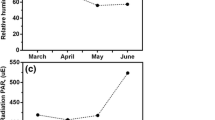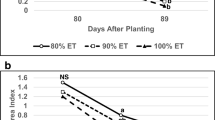Abstract
Droughts are common in the US High Plains, causing declining water availability and lowering water allocations. The objective of this 4-year field study was to identify a period of water deficit least detrimental to potato production. Fully irrigated ‘Atlantic’ potato received 62–63 cm of applied water. Total applied water was reduced by 25 % in three seasonal periods, 50 % water from emergence to 8 weeks after emergence (WAE) (early stress), 50 % water from 8 to 13 WAE (late stress), and 50 % from 0 to 5 WAE and again from 10 to 13 WAE (outer stress). Main plots were irrigation regime and split with three N levels, 101, 168, and 235 kg/ha. Soil and petiole N were higher when applied water was reduced. Lower irrigation inhibited growth, i.e., canopy height (10–20 %), weight (20–30 %) and leaf area index (50–70 %). Yield decreased 25 % and 13 % with early and outer stress, respectively. Chip color was darkest with early stress compared to fully irrigated plots. Common scab occurrence was greater in early stress than with other regimes. N rate had no effect on canopy growth, yield, chip color, or common scab. If applied water is reduced 15 cm, it is best late in the season and worst between 5 and 8 WAE compared to fully irrigated plants
Resumen
Las sequías son comunes en las planicies altas de EUA, causando disminución en la disponibilidad de agua y bajando su ubicación. El objetivo de este estudio de campo de cuatro años fue identificar un período de déficit de agua que fuera lo menos perjudicial para la producción de papa. La papa Atlantic con riego completo recibió de 62 a 63 cm de agua. El total del agua aplicada se redujo en un 25 % en tres ciclos, 50 % de agua de la emergencia a 8 semanas después de la emergencia (WAE) (agobio temprano), 50 % de agua de 8 a13 WAE (agobio tardío), y 50 % de 0 a 5 WAE y otra vez de 10 a 13 WAE (agobio externo). Los lotes principales tuvieron regímenes de riego y fueron divididos con tres niveles de N, 101, 168, y 235 kg/ha. El N del suelo y del pecíolo fue más alto cuando se redujo el agua aplicada. Los riegos más bajos inhibieron crecimiento, i.e., altura del follaje (10–20 %), peso (20–30 %) y el índice de área foliar (50–70 %). El rendimiento disminuyó 25 % y 13 % con agobio temprano y externo, respectivamente. El color de la hojuela fue el más oscuro con agobio temprano comparado con los lotes de riego completo. La incidencia de la roña común fue mayor en agobio temprano que con los otros regímenes. El nivel de N no tuvo efecto en el crecimiento del follaje, rendimiento, color de la hojuela, o roña común. Si el agua aplicada se reduce 15 cm, es mejor tarde en el ciclo y peor entre 5 y 8 WAE en comparación con plantas de riego completo.


Similar content being viewed by others
References
Alva A.K. 2008. Setpoints for potato irrigation in sandy soils using real-time, continuous monitoring of soil-water content in soil profile. Journal of Crop Improvement 21: 117–137. doi:10.1080/15427520701885311.
Basara, J.B., Maybourn, J.N., Peirano, C.M., Tate, J.E., Brown. P.J., Hoey, J.D., Smith, B.R. 2013. Drought and associated impacts in the great plains of the United States - a review. International Journal of Geosciences 4:72–81.
Bleed, J.B., Babbitt, C.H. 2015. Nebraska’s Natural Resources Districts: An assessment of a large-scale locally controlled water governance framework. Policy Report 1, Robert B. Daugherty Water for Food Inst., Univ. of Nebraska-Lincoln, 155 pp.
Changnon S.A., P. Lamb, and K.G. Hubbard. 1990. Regional climate centers: new institutions for climate services and climate-impact research. Bulletin of the American Meteorological Society 71: 527–537.
Dalla Costa L., G. Delle Vedove, G. Gianquinto, R. Giovanardi, and A. Peressotti. 1997. Yield, water use efficiency and nitrogen uptake in potato: influence of drought stress. Potato Research 40: 19–34.
Deblonde P., and J.F. Ledent. 2000. Effects of moderate drought conditions on crop growth parameters and earliness of six potato cultivars under field conditions. Agronomie 20: 595–608.
Deblonde P.M.K., A.J. Haverkort, and J.F. Ledent. 1999. Responses of early and late potato cultivars to moderate drought conditions: agronomic parameters and carbon isotope discrimination. European Journal of Agronomy 11: 91–105.
Fabeiro C., R. Martin de Santa Olalla, and J.A. de Juan. 2001. Yield and size of deficit irrigated potatoes. Agricultural Water Management 48: 255–266.
Ferreira T.C., and M.K.V. Carr. 2002. Responses of potatoes (Solanum tuberosum L.) to irrigation and nitrogen in a hot, dry climate. Field Crops Research 78: 51–64.
Fleisher D.H., D.J. Timlin, and V.R. Reddy. 2008. Interactive effects of carbon dioxide and water stress on potato canopy growth and development. Agronomy Journal 100: 711–719.
Geerts S., and D. Raes. 2009. Deficit irrigation as an on-farm strategy to maximize crop water productivity in dry areas. Agricultural Water Management 96: 1275–1284.
Gould, W.A. and S. Plimpton. 1985. Quality evaluation of potato cultivars for processing. North Central Regional Research Pulication # 305.
Hergert G.W., N.L. Klocke, J.L. Petersen, P.T. Nordquist, R.T. Clark, and G.A. Wicks. 1993. Cropping systems for stretching limited irrigation supplies. Journal of Production Agriculture 6: 520–529.
Iwama K. 2008. Physiology of the potato: new insights into root system and reprecussions for crop management. Potato Research 51: 333–353. doi:10.1007/s11540-008-9120-3.
Karam, F., N. Amacha, S. Fahed, T. El Asmar, and A. Dominguez. 2014. Response of potato to full and deficit irrigation under semiarid climate: Agronomic and economic implications. Agricultural Water Management 142:144–151. doi.org/10.1016/j.agwat.2014.05.007
Kashyap P.S., and R.K. Panda. 2003. Effect of irrigation scheduling on potato crop parameters under water stressed conditions. Agricultural Water Management 59: 49–66.
Lahlou O., S. Ouattar, and J.F. Ledent. 2003. The effect of drought and cultivar on growth parameters, yield and yield components of potato. Agronomie 23: 257–268.
Lapwood D.H., and T.F. Hering. 1970. Soil moisture and the infection of young potato tubers by Streptomyces scabies (common scab). Potato Research 13: 296–304.
Lapwood D.H., L.W. Welling, and J.H. Hawkins. 1973. Irrigation as a practical means to control potato common scab (Streptomyces scabies): final experiment and conclusions. Plant Pathology 22: 35–41.
Levy D. 1985. The response of potatoes to a single transient heat or drought stress imposed at different stages of tuber growth. Potato Research 28: 415–424.
Levy D., W.K. Coleman, and R.E. Veilleux. 2013. Adaptation of potato to water shortage: irrigation management and enhancement of tolerance to drought and salinity. American Journal of Potato Research 90: 186–206. doi:10.1007/s12230-012-9291-y.
Ojala J.C., J.C. Stark, and G.E. Kleinkopf. 1990. Influence of irrigation and nitrogen management on potato yield and quality. American Potato Journal 67: 29–43.
Onder S., M.E. Caliskan, D. Onder, and S. Caliskan. 2005. Different irrigation methods and water stress effects on potato yield and yield components. Agricultural Water Management 73: 73–86.
Painter C.G., and J. Augustin. 1976. The effect of soil moisture and nitrogen on yield and quality of the russet Burbank potato. American Potato Journal 53: 275–284.
Pavlista, A.D. 1995. Potato production stages: Scheduling key practices. Univ. Nebraska Ext. Circ. #1249. Potato Education Guide. http://cropwatch.unl.edu/web/potato/key_production_stages
Pavlista A.D. 1997. Potato types & characteristics: laboratory exercises. The Amer. Biology Teacher 59: 30–34.
Robins J.S., and C.E. Domingo. 1956. Potato yield and tuber shape as affected by severe soil-moisture deficits and plant spacing. Agronomy Journal 48: 488–492.
SAS Institute. 2003. SAS System for Windows. Release 9.1. ed. SAS Institute Inc., Cary, NC.
Sharma N., P. Kumar, M.S. Kadian, S.K. Pandey, S.V. Singh, and S.K. Luthra. 2011. Performance of potato (Solanum tuberosum) clones under water stress. Indian Journal Agricultural Sciences 81: 825–829.
Shock C.C., E.B.G. Feibert, and L.D. Saunders. 1998. Potato yield and quality response to deficit irrigation. Hortscience 33: 655–659.
Shock C.C., A.B. Pereira, and E.P. Eldredge. 2007. Irrigation best management practices for potato. American Journal of Potato Research 84: 29–37.
Singh G. 1969. A review of the soil-moisture relationship in potatoes. American Potato Journal 46: 398–403.
Stark J.C., and I.R. McCann. 1992. Optimal allocation of limited water supplies for russet Burbank potatoes. American Potato Journal 69: 413–421.
Stark J.C., S.L. Love, B.A. King, J.M. Marchall, W.H. Bohl, and T. Salaiz. 2013. Potato cultivar response to seasonal drought patterns. American Journal of Potato Research 90: 307–316.
Tourneux C., A. Devaux, M.R. Camacho, P. Mamant, and J.F. Ledent. 2003. Effects of water shortage on six potato genotypes in the highlands of Bolivia (I): morphological parameters, growth and yield. Agronomie 23: 169–179.
Trebejo I., and D.J. Midmore. 1990. Effect of water stress on potato growth, yield and water use in a hot and a cool tropical climate. Journal of Agriculture Science (Cambridge) 114: 321–334.
van Loon C.D. 1981. The effect of water stress on potato growth. Development, and yield. American Potato Journal 58: 51–69.
Vos, J. and A.J. Haverkort. 2007. Water availability and potato crop performance. In Potato Biology and Biotechnology Advances and Perspectives, eds. D. Vreugdenhil, J. Bradshaw, C. Gebhardt, F. Govers, M.A. Taylor, D.K.I. McKerron, and H.A. Ross. pub. Elsevier. Amsterdam, The Netherlands. pp. 333–351.
Walworth J.L., and D.E. Carling. 2002. Tuber initiation and development in irrigated and non-irrigated potatoes. American Journal of Potato Research 79: 387–395.
Wright J.L., and J.C. Stark. 1990. Potato. In irrigation of agricultural crops, eds, 859–887. Madison, WI, USA: B.A. Stewart and D.R. Nielsen. pub. ASA/CSSA/SSSA.
Acknowledgments
The author is grateful for the technical support of Les Kampbell, Allison Hazen and Todd Wilson, and the assistance of summer interns. I give special appreciation for the financial support of the USDA Specialty Crops Block Grant Program administered by the Nebraska Department of Agriculture.
Author information
Authors and Affiliations
Corresponding author
Rights and permissions
About this article
Cite this article
Pavlista, A.D. Scheduling Reduced Irrigation on ‘Atlantic’ Potato for Minimal Effect. Am. J. Potato Res. 92, 673–683 (2015). https://doi.org/10.1007/s12230-015-9483-3
Published:
Issue Date:
DOI: https://doi.org/10.1007/s12230-015-9483-3




